brakes Lancia Ypsilon 2002 Owner handbook (in English)
[x] Cancel search | Manufacturer: LANCIA, Model Year: 2002, Model line: Ypsilon, Model: Lancia Ypsilon 2002Pages: 191, PDF Size: 2.45 MB
Page 24 of 191
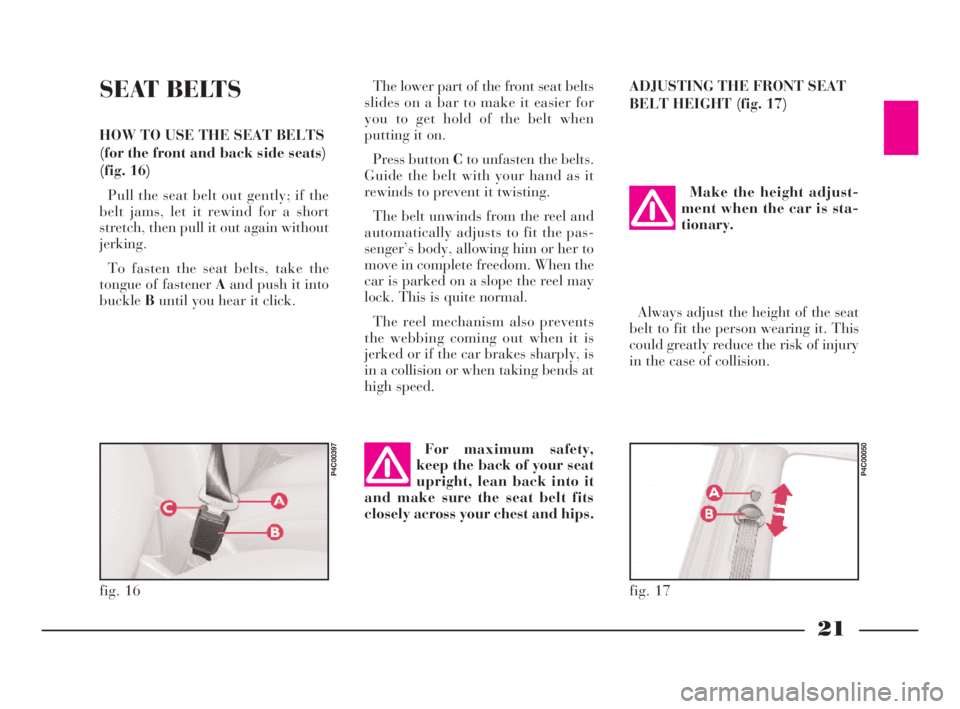
21
G
SEAT BELTS
HOW TO USE THE SEAT BELTS
(for the front and back side seats)
(fig. 16)
Pull the seat belt out gently; if the
belt jams, let it rewind for a short
stretch, then pull it out again without
jerking.
To fasten the seat belts, take the
tongue of fastener Aand push it into
buckleBuntil you hear it click.The lower part of the front seat belts
slides on a bar to make it easier for
you to get hold of the belt when
putting it on.
Press button Cto unfasten the belts.
Guide the belt with your hand as it
rewinds to prevent it twisting.
The belt unwinds from the reel and
automatically adjusts to fit the pas-
senger’s body, allowing him or her to
move in complete freedom. When the
car is parked on a slope the reel may
lock. This is quite normal.
The reel mechanism also prevents
the webbing coming out when it is
jerked or if the car brakes sharply, is
in a collision or when taking bends at
high speed.ADJUSTING THE FRONT SEAT
BELT HEIGHT (fig. 17)
For maximum safety,
keep the back of your seat
upright, lean back into it
and make sure the seat belt fits
closely across your chest and hips.
fig. 17
P4C00050
Make the height adjust-
ment when the car is sta-
tionary.
Always adjust the height of the seat
belt to fit the person wearing it. This
could greatly reduce the risk of injury
in the case of collision.
fig. 16
P4C00397
4C001-067 ING 11-03-2008 11:57 Pagina 21
Page 60 of 191

57
G
In the case of failure, although the
anti-locking system is no longer avail-
able, the car braking capacity is not
interfered with.
If you have never driven a car with
ABS it is advised to familiarise by
making a few preliminary trials on
slippery ground, obviously maintain-
ing safety conditions and respecting
the Highway Code of the country
where you are travelling. Before start-
ing, read carefully the notes below.
The advantage of ABS as compared
with the traditional system is that it
permits maximum manoeuvrability
even when pressing the brakes right
down on roads with poor grip, pre-
venting the wheels from locking.
However, this does not mean that
with ABS the braking distance is al-
ways reduced. For example, on soft
gravel surfaces or fresh snow on a
slippery surface the distance could in-
crease.In order to get the best out of the
anti-lock system when necessary, fol-
low these hints.
If the ABS triggers it
means that the car is
reaching the limit of ad-
herence between the tyres and the
road surface. Slow down to adapt
the speed to the road grip.
ABS exploits the avail-
able grip, but it is not able
to increase it. Therefore
drive carefully on slippery surfaces
and do not take undue risks.
If there is a system fail-
ure, indicated by warning
light>lighting up on the
instrument panel, drive slowly and
go immediately to a LANCIA Deal-
ership to have the system checked.
When braking round a bend be very
careful, even with the aid of ABS.
However, the most important advice
is the following:
When the ABS switches
on and you feel the pedal
throbbing, no not lighten
the pressure, but keep the pedal
pressed well down and do not
worry. In this way you will be able
to stop within the minimum dis-
tance possible, according to the
road surface.
Following these instructions you will
be always have the best braking con-
ditions.
4C001-067 ING 11-03-2008 11:57 Pagina 57
Page 80 of 191
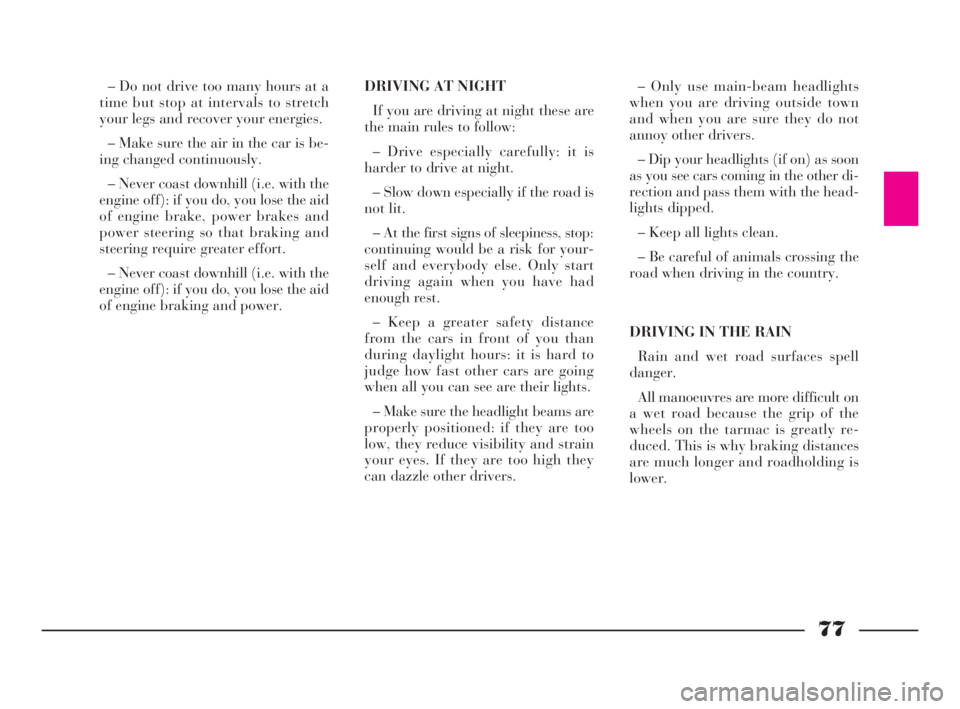
77
G
– Only use main-beam headlights
when you are driving outside town
and when you are sure they do not
annoy other drivers.
– Dip your headlights (if on) as soon
as you see cars coming in the other di-
rection and pass them with the head-
lights dipped.
– Keep all lights clean.
– Be careful of animals crossing the
road when driving in the country.
DRIVING IN THE RAIN
Rain and wet road surfaces spell
danger.
All manoeuvres are more difficult on
a wet road because the grip of the
wheels on the tarmac is greatly re-
duced. This is why braking distances
are much longer and roadholding is
lower. DRIVING AT NIGHT
If you are driving at night these are
the main rules to follow:
– Drive especially carefully: it is
harder to drive at night.
– Slow down especially if the road is
not lit.
– At the first signs of sleepiness, stop:
continuing would be a risk for your-
self and everybody else. Only start
driving again when you have had
enough rest.
– Keep a greater safety distance
from the cars in front of you than
during daylight hours: it is hard to
judge how fast other cars are going
when all you can see are their lights.
– Make sure the headlight beams are
properly positioned: if they are too
low, they reduce visibility and strain
your eyes. If they are too high they
can dazzle other drivers. – Do not drive too many hours at a
time but stop at intervals to stretch
your legs and recover your energies.
– Make sure the air in the car is be-
ing changed continuously.
– Never coast downhill (i.e. with the
engine off): if you do, you lose the aid
of engine brake, power brakes and
power steering so that braking and
steering require greater effort.
– Never coast downhill (i.e. with the
engine off): if you do, you lose the aid
of engine braking and power.
4C068-089 ING 11-03-2008 11:59 Pagina 77
Page 82 of 191
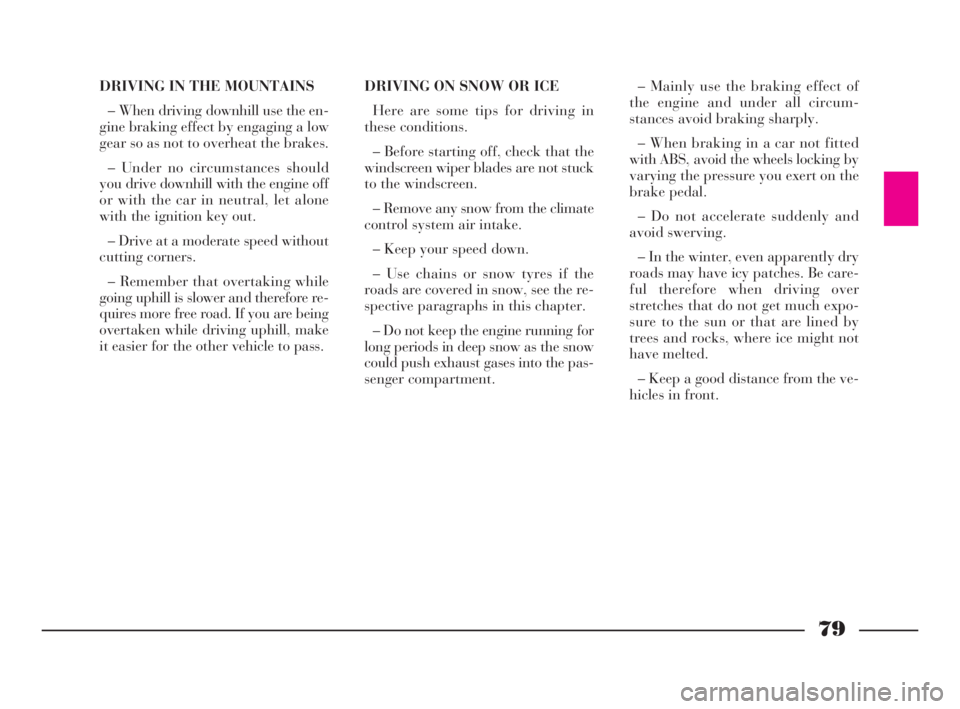
79
G
DRIVING IN THE MOUNTAINS
– When driving downhill use the en-
gine braking effect by engaging a low
gear so as not to overheat the brakes.
– Under no circumstances should
you drive downhill with the engine off
or with the car in neutral, let alone
with the ignition key out.
– Drive at a moderate speed without
cutting corners.
– Remember that overtaking while
going uphill is slower and therefore re-
quires more free road. If you are being
overtaken while driving uphill, make
it easier for the other vehicle to pass.DRIVING ON SNOW OR ICE
Here are some tips for driving in
these conditions.
– Before starting off, check that the
windscreen wiper blades are not stuck
to the windscreen.
– Remove any snow from the climate
control system air intake.
– Keep your speed down.
– Use chains or snow tyres if the
roads are covered in snow, see the re-
spective paragraphs in this chapter.
– Do not keep the engine running for
long periods in deep snow as the snow
could push exhaust gases into the pas-
senger compartment.– Mainly use the braking effect of
the engine and under all circum-
stances avoid braking sharply.
– When braking in a car not fitted
with ABS, avoid the wheels locking by
varying the pressure you exert on the
brake pedal.
– Do not accelerate suddenly and
avoid swerving.
– In the winter, even apparently dry
roads may have icy patches. Be care-
ful therefore when driving over
stretches that do not get much expo-
sure to the sun or that are lined by
trees and rocks, where ice might not
have melted.
– Keep a good distance from the ve-
hicles in front.
4C068-089 ING 11-03-2008 11:59 Pagina 79
Page 126 of 191
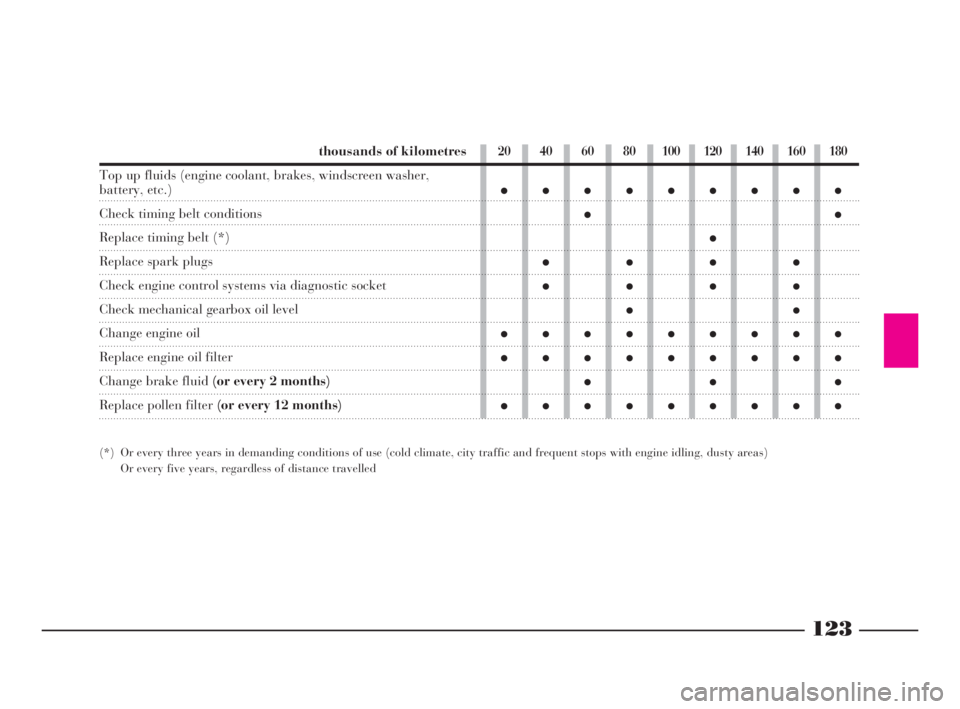
123
G
thousands of kilometres
Top up fluids (engine coolant, brakes, windscreen washer,
battery, etc.)
Check timing belt conditions
Replace timing belt (*)
Replace spark plugs
Check engine control systems via diagnostic socket
Check mechanical gearbox oil level
Change engine oil
Replace engine oil filter
Change brake fluid (or every 2 months)
Replace pollen filter (or every 12 months)
(*) Or every three years in demanding conditions of use (cold climate, city traffic and frequent stops with engine idling, dusty areas)
Or every five years, regardless of distance travelled
20 40 60 80 100 120 140 160 180
●●●●●●●●●
●●
●
●●●●
●●●●
●●
●●●●●●●●●
●●●●●●●●●
●●●
●●●●●●●●●
4C120-143 ING 11-03-2008 12:01 Pagina 123
Page 127 of 191
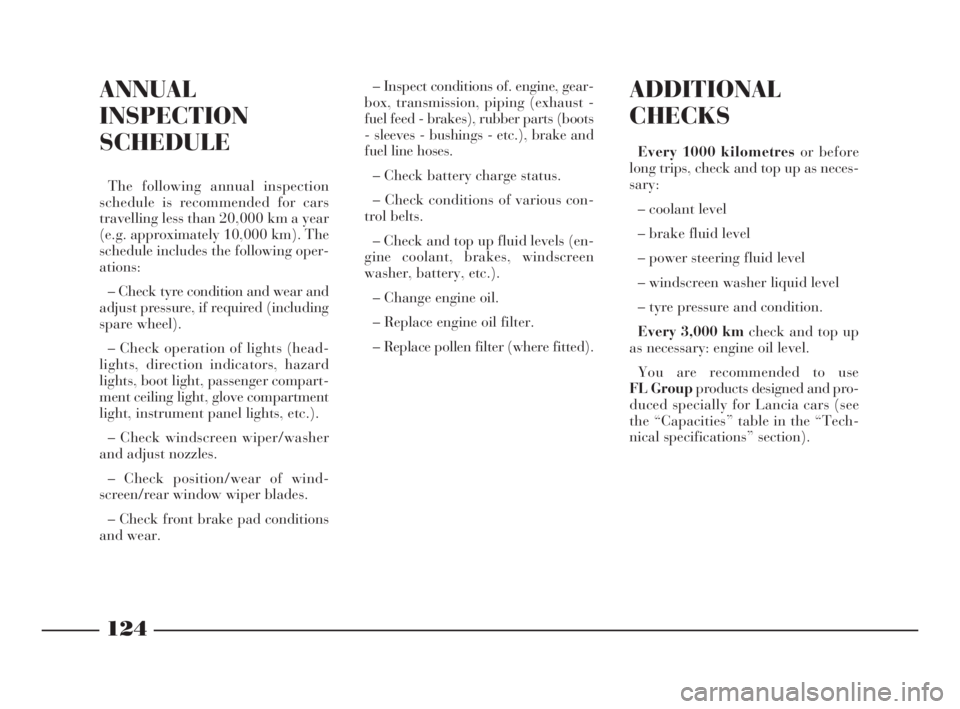
124
G
ADDITIONAL
CHECKS
Every 1000 kilometres or before
long trips, check and top up as neces-
sary:
– coolant level
– brake fluid level
– power steering fluid level
– windscreen washer liquid level
– tyre pressure and condition.
Every 3,000 kmcheck and top up
as necessary: engine oil level.
You are recommended to use
FL Groupproducts designed and pro-
duced specially for Lancia cars (see
the “Capacities” table in the “Tech-
nical specifications” section).
ANNUAL
INSPECTION
SCHEDULE
The following annual inspection
schedule is recommended for cars
travelling less than 20,000 km a year
(e.g. approximately 10,000 km). The
schedule includes the following oper-
ations:
– Check tyre condition and wear and
adjust pressure, if required (including
spare wheel).
– Check operation of lights (head-
lights, direction indicators, hazard
lights, boot light, passenger compart-
ment ceiling light, glove compartment
light, instrument panel lights, etc.).
– Check windscreen wiper/washer
and adjust nozzles.
– Check position/wear of wind-
screen/rear window wiper blades.
– Check front brake pad conditions
and wear.– Inspect conditions of. engine, gear-
box, transmission, piping (exhaust -
fuel feed - brakes), rubber parts (boots
- sleeves - bushings - etc.), brake and
fuel line hoses.
– Check battery charge status.
– Check conditions of various con-
trol belts.
– Check and top up fluid levels (en-
gine coolant, brakes, windscreen
washer, battery, etc.).
– Change engine oil.
– Replace engine oil filter.
– Replace pollen filter (where fitted).
4C120-143 ING 11-03-2008 12:01 Pagina 124
Page 147 of 191
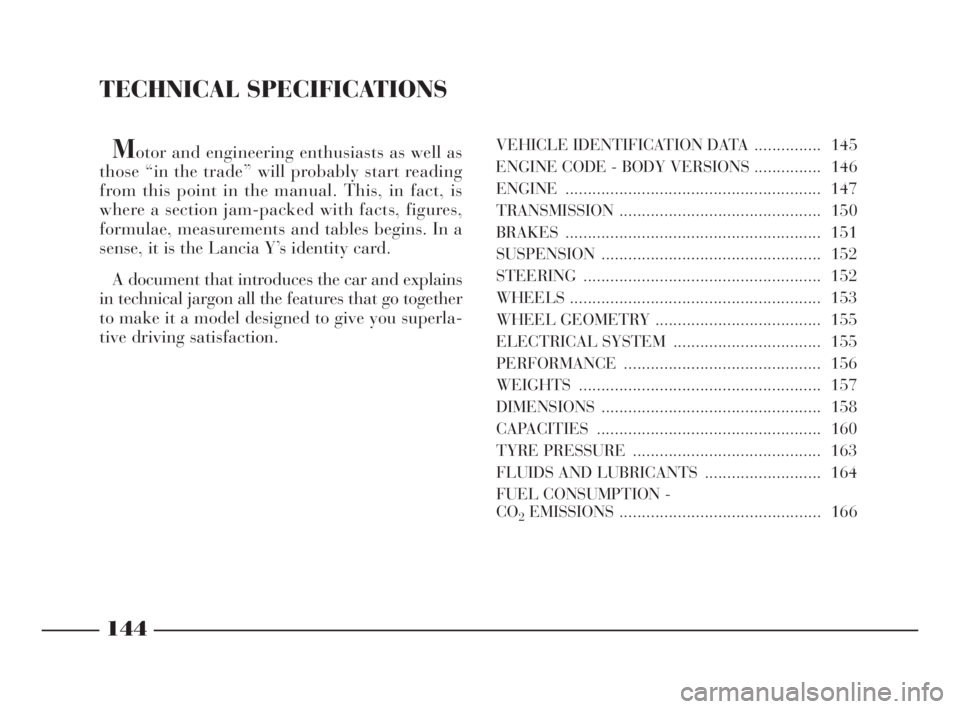
TECHNICAL SPECIFICATIONS
Motor and engineering enthusiasts as well as
those “in the trade” will probably start reading
from this point in the manual. This, in fact, is
where a section jam-packed with facts, figures,
formulae, measurements and tables begins. In a
sense, it is the Lancia Y’s identity card.
A document that introduces the car and explains
in technical jargon all the features that go together
to make it a model designed to give you superla-
tive driving satisfaction.VEHICLE IDENTIFICATION DATA ............... 145
ENGINE CODE - BODY VERSIONS............... 146
ENGINE......................................................... 147
TRANSMISSION............................................. 150
BRAKES......................................................... 151
SUSPENSION ................................................. 152
STEERING..................................................... 152
WHEELS........................................................ 153
WHEEL GEOMETRY ..................................... 155
ELECTRICAL SYSTEM ................................. 155
PERFORMANCE............................................ 156
WEIGHTS...................................................... 157
DIMENSIONS................................................. 158
CAPACITIES .................................................. 160
TYRE PRESSURE .......................................... 163
FLUIDS AND LUBRICANTS .......................... 164
FUEL CONSUMPTION -
CO
2EMISSIONS ............................................. 166
144
G
4C144-167 ING 11-03-2008 12:02 Pagina 144
Page 154 of 191

151
G
Drive transmission to the front
wheels by means of half-shafts con-
nected to the differential assembly
and the wheels with CV joints.
The ratios are:Final drive gear and differential as-
sembly incorporated in the gearbox.
Version Final drive ratio Number of teeth
1.2 3.438 16/55
1.216V3.438 16/55
1.216VM Nrosso3.867 15/58
BRAKES
SERVICE AND EMERGENCY
BRAKES
Cross-over hydraulic circuit control.
8" vacuum brake booster.
Front: disc, floating caliper type with
operating cylinder for each wheel.
Rear: drum type with self-centring
shoes with operating cylinder for each
wheel.
Automatic take up of clearance due
to friction lining wear.
Brake effort apportioning valve
working on the hydraulic circuit of
the rear brakes (for versions without
ABS).
Four channel, four sensor ABS (op-
tional for 1.2 versions, standard for LX
and 1.2
16Vversions) with electronic
brake force distributor.
HANDBRAKE
Controlled by a lever, it works me-
chanically on the rear brake shoes.
4C144-167 ING 11-03-2008 12:02 Pagina 151
Page 160 of 191
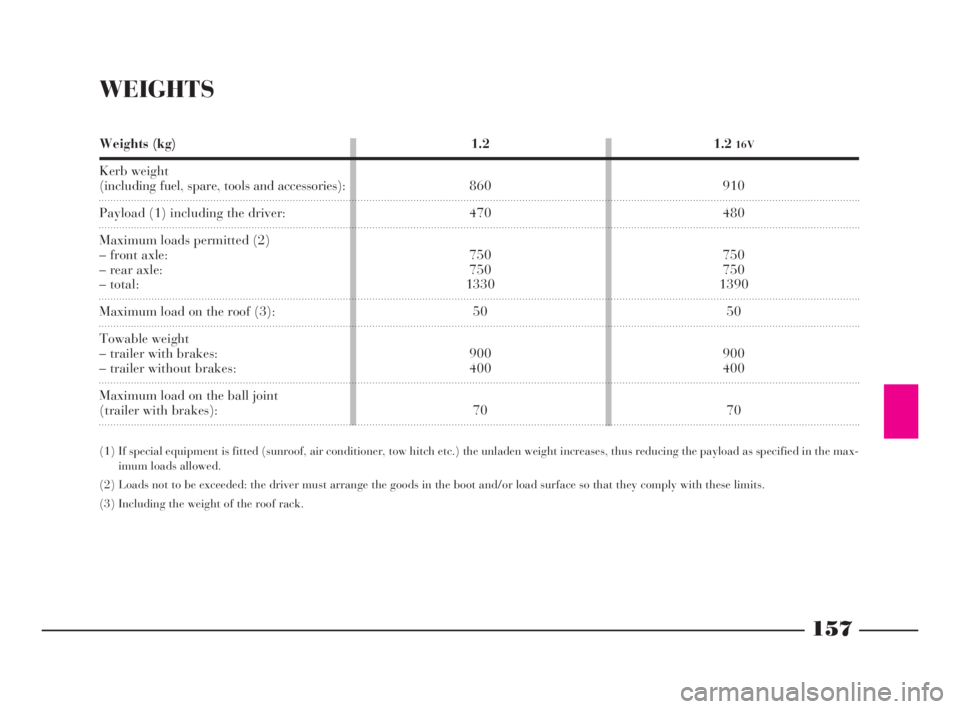
157
G
WEIGHTS
Weights (kg)
Kerb weight
(including fuel, spare, tools and accessories):
Payload (1) including the driver:
Maximum loads permitted (2)
– front axle:
– rear axle:
– total:
Maximum load on the roof (3):
Towable weight
– trailer with brakes:
– trailer without brakes:
Maximum load on the ball joint
(trailer with brakes):1.2
16V
910
480
750
750
1390
50
900
400
70 1.2
860
470
750
750
1330
50
900
400
70
(1) If special equipment is fitted (sunroof, air conditioner, tow hitch etc.) the unladen weight increases, thus reducing the payload as specified in the max-
imum loads allowed.
(2) Loads not to be exceeded: the driver must arrange the goods in the boot and/or load surface so that they comply with these limits.
(3) Including the weight of the roof rack.
4C144-167 ING 11-03-2008 12:02 Pagina 157
Page 180 of 191
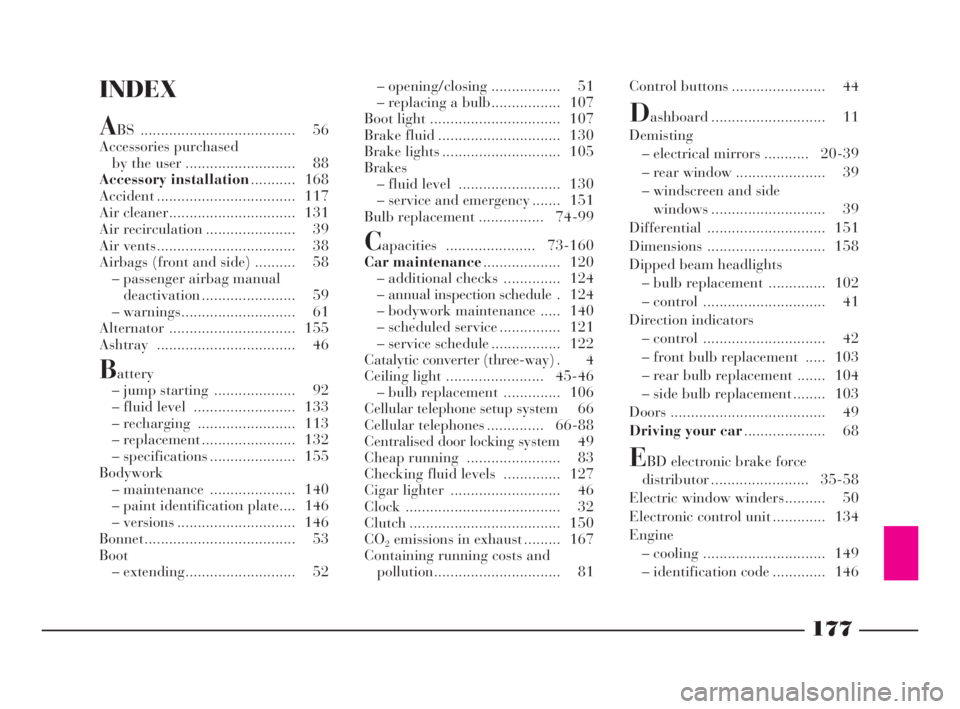
177
fdG
INDEX
ABS ...................................... 56
Accessories purchased
by the user ........................... 88
Accessory installation........... 168
Accident .................................. 117
Air cleaner............................... 131
Air recirculation ...................... 39
Air vents.................................. 38
Airbags (front and side) .......... 58
– passenger airbag manual
deactivation ....................... 59
– warnings............................ 61
Alternator ............................... 155
Ashtray .................................. 46
Battery
– jump starting .................... 92
– fluid level ......................... 133
– recharging ........................ 113
– replacement ....................... 132
– specifications ..................... 155
Bodywork
– maintenance ..................... 140
– paint identification plate.... 146
– versions ............................. 146
Bonnet..................................... 53
Boot
– extending........................... 52– opening/closing ................. 51
– replacing a bulb................. 107
Boot light ................................ 107
Brake fluid .............................. 130
Brake lights ............................. 105
Brakes
– fluid level ......................... 130
– service and emergency ....... 151
Bulb replacement ................ 74-99
Capacities ...................... 73-160
Car maintenance................... 120
– additional checks .............. 124
– annual inspection schedule . 124
– bodywork maintenance ..... 140
– scheduled service ............... 121
– service schedule ................. 122
Catalytic converter (three-way) . 4
Ceiling light ........................ 45-46
– bulb replacement .............. 106
Cellular telephone setup system 66
Cellular telephones .............. 66-88
Centralised door locking system 49
Cheap running ....................... 83
Checking fluid levels .............. 127
Cigar lighter ........................... 46
Clock ...................................... 32
Clutch ..................................... 150
CO
2emissions in exhaust ......... 167
Containing running costs and
pollution............................... 81Control buttons ....................... 44
Dashboard ............................ 11
Demisting
– electrical mirrors ........... 20-39
– rear window ...................... 39
– windscreen and side
windows ............................ 39
Differential ............................. 151
Dimensions ............................. 158
Dipped beam headlights
– bulb replacement .............. 102
– control .............................. 41
Direction indicators
– control .............................. 42
– front bulb replacement ..... 103
– rear bulb replacement ....... 104
– side bulb replacement ........ 103
Doors ...................................... 49
Driving your car.................... 68
EBD electronic brake force
distributor ........................ 35-58
Electric window winders.......... 50
Electronic control unit ............. 134
Engine
– cooling .............................. 149
– identification code ............. 146
4C177-184 Indice ING 13-03-2008 13:31 Pagina 177